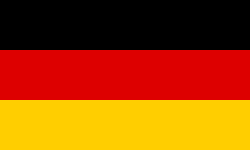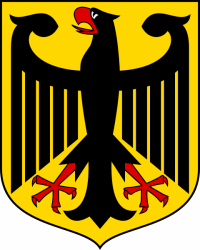Federal Republic of Germany
Related Categories:
 Flag of Germany
Flag of GermanyThree equal horizontal bands of black (top), red, and gold. |

 Germany Coat of Arms
Germany Coat of Arms |
The use of swastikas is banned under German law. But they are a common element in symbols used by the left-wing movement. The Stuttgart district attorney now wants legal clarity on this contradiction.
www.dw-world.de/dw/
As the western occupation zones moved to unity in the last years of the 1940s, it became obvious that the governmental entity which would develop would adopt the black-red-gold of the Weimar Republic.
www.fotw.us/flags/de.html Germany - wikipedia.org
The ethnogenesis of the Germanic tribes is assumed to have occurred during the Nordic Bronze Age, or at the latest, during the Pre-Roman Iron Age.
en.wikipedia.org/
Most inhabitants of Germany are ethnic German. There are, however, more than 7 million foreign residents, including asylees, guest workers, and their dependents. Germany is a prime destination for political and economic refugees from many developing countries. An ethnic Danish minority lives in the north, and a small Slavic minority known as the Sorbs lives in eastern Germany.
Germany has one of the world's highest levels of education, technological development, and economic productivity. Since the end of World War II, the number of youths entering universities has more than tripled, and the trade and technical schools of the Federal Republic of Germany (F.R.G.) are among the world's best. With a per capita income level of more than $22,900, Germany is a broadly middle class society. A generous social welfare system provides for universal medical care, unemployment compensation, and other social needs. Millions of Germans travel abroad each year.
With unification on October 3, 1990, Germany began the major task of bringing the standard of living of Germans in the former German Democratic Republic (G.D.R.) up to that of western Germany. This has been a lengthy and difficult process due to the relative inefficiency of industrial enterprises in the former G.D.R., difficulties in resolving property ownership in eastern Germany, and the inadequate infrastructure and environmental damage that resulted from years of mismanagement under communist rule.
Economic uncertainty in eastern Germany is often cited as one factor contributing to extremist violence, primarily from the political right. Confusion about the causes of the current hardships and a need to place blame has found expression in harassment and violence by some Germans directed toward foreigners, particularly non-Europeans. The vast majority of Germans condemn such violence.
www.state.gov/r/
Introduction
About
Contact
Symbols in The News
Interpret this Symbol
AAC
African
AI
Alchemy
Alphabets
Ancient
Animal Symbolism
Architecture
Art
Articles
Astrology
Baha'i
Blissymbolics
Blueprint Symbols
Buddhist
Celtic Symbols
Cemetery
Chinese Symbols
Christian
Circle
City
Codes
Color
Conlangs
Crop Circles
Danger
Da Vinci Code
Designing Logos
Dictionaries
Dreams
Education
Egyptian Symbols
Electrical
Emoticons
Find Images
Fonts
Food
Fraternity
Hamsa
Healing
Heraldry
Hermetic
Highway Signs
Hindu
History
Hobo
Holiday
Icons
iConji
Islamic
Jain Symbols
Japanese, Kanji
Jewish
Justice
Law
Literary Symbolism
Mandalas
Map
Masonic
Math, Number
Meaning of Names
Medical
Middle East
Military
Miscellaneous
Money
Music
Mythology
Native American
Playing Cards
Power
Psychology
QiQiiKhu
Reiki
Religious
Runes, Norse
Sacred Geometry
Scientific
Science Fiction
Sorority
Sports
Symbols in the News
Tattoos
ThirteenSymbols
Tree of Life
Ursprache
Videos
Visual Languages
Weather
Web Codes
Wicca
Words
Writing Systems
Braille
Coinherence
Coptic
Cuneiform
Easter Island
Etruscan
Happy Human
Hebrew
Kokopelli
Linear B
Lotus
Love Symbols
Mandorla
Moon Alphabet
Nine Pointed Star
Om
Oz
Phonetic
Scarab Beetle
Silent
Theosophy
Unifon
About
Contact
Symbols in The News
Interpret this Symbol
AAC
African
AI
Alchemy
Alphabets
Ancient
Animal Symbolism
Architecture
Art
Articles
Astrology
Baha'i
Blissymbolics
Blueprint Symbols
Buddhist
Celtic Symbols
Cemetery
Chinese Symbols
Christian
Circle
City
Codes
Color
Conlangs
Crop Circles
Danger
Da Vinci Code
Designing Logos
Dictionaries
Dreams
Education
Egyptian Symbols
Electrical
Emoticons
Find Images
Fonts
Food
Fraternity
Hamsa
Healing
Heraldry
Hermetic
Highway Signs
Hindu
History
Hobo
Holiday
Icons
iConji
Islamic
Jain Symbols
Japanese, Kanji
Jewish
Justice
Law
Literary Symbolism
Mandalas
Map
Masonic
Math, Number
Meaning of Names
Medical
Middle East
Military
Miscellaneous
Money
Music
Mythology
Native American
Playing Cards
Power
Psychology
QiQiiKhu
Reiki
Religious
Runes, Norse
Sacred Geometry
Scientific
Science Fiction
Sorority
Sports
Symbols in the News
Tattoos
ThirteenSymbols
Tree of Life
Ursprache
Videos
Visual Languages
Weather
Web Codes
Wicca
Words
Writing Systems
Braille
Coinherence
Coptic
Cuneiform
Easter Island
Etruscan
Happy Human
Hebrew
Kokopelli
Linear B
Lotus
Love Symbols
Mandorla
Moon Alphabet
Nine Pointed Star
Om
Oz
Phonetic
Scarab Beetle
Silent
Theosophy
Unifon
